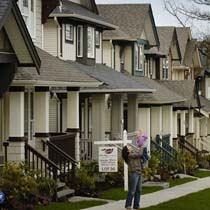Planners want a ban on residential development in a new commercial area and more density for office towers
Frances Bula
Sun

Vancouver is about to radically reshape its downtown business core to create new commercial office space and keep condos at bay.
City planners are proposing that residential development be banned from an expanded new commercial district, that office towers automatically be granted 20 to 40 per cent more density, and developers be encouraged to build as high as possible without blocking designated views.
“When you look at the capacity for job space in the city, there’s a problem, particularly in the downtown,” said planner Kevin McNaney, who is in charge of the city’s massive metro-core jobs study that has been examining occupations and locations the city will need in the future. “And it really has nowhere to go but up. There’s heritage on one side, strata condos on the others and then the port.”
The city is also proposing that all conversions from office to residential in buildings over 50,000 square feet will be discouraged through the new central business district, which will now stretch from Bute to Beatty and Robson to Cordova. Similarly, conversions of buildings over 30,000 square feet in Yaletown, Chinatown and Gastown will also be discouraged.
That change is being welcomed by the business community, which has been raising the alarm for a couple of years about the way office development has been losing the battle to more profitable condo development.
“It’s all good to walk and bike to work, but if you don’t have offices for people to go to, that makes things rather difficult,” said Bernie Magnan, the chief economist for the Vancouver Board of Trade. “You won’t have the business and the jobs that you’re asking people to move down here for.”
Condominium development in the downtown core has been escalating for 20 years, ever since the city started promoting a “Living First” policy of encouraging people to move downtown. It took off in the late 1980s, after the office market collapsed in Vancouver and elsewhere and developers were looking for new opportunities to build. Since then, the size of the downtown population has more than doubled to about 90,000.
As it became clear that condo projects were selling at phenomenal rates and available sites became less and less available, residential developers started pushing into the central business district or converting former office buildings. The famous one-time Westcoast Transmission building on Georgia became the Qube condos, while prime sites, one at Georgia and Thurlow and one at Dunsmuir at Granville, were developed as the Shangri-La and Hudson, which were all or partly condos.
The city put a moratorium on that kind of conversion and development almost four years ago, because of concern about the effect it was having on the price of the remaining commercial land. In the meantime, the office vacancy rate downtown has dropped to a record low.
City planners have estimated that the downtown needs about six million square feet more of office space to accommodate an increase from the 120,000 jobs that now exist downtown.
McNaney said the city will also be making changes in other parts of what it calls the metro core — everything north of 16th Avenue from Clark to Arbutus — to create more job space.
He said that it’s unlikely that Vancouver will see exceptionally high office towers because the business market in Vancouver isn’t strong enough for that. Vancouver has no head offices and much of its office space goes to companies leasing relatively small amounts of space.
© The Vancouver Sun 2008






